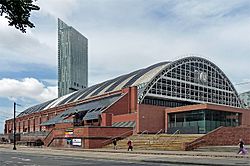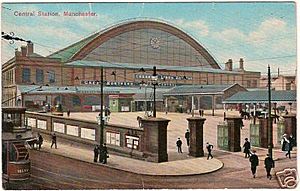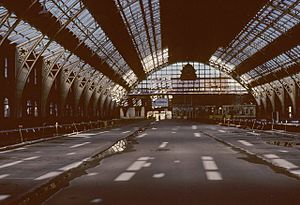Manchester Central Convention Complex facts for kids
Quick facts for kids Manchester Central Convention Complex |
|
|---|---|
 |
|
| Former names | Greater Manchester Exhibition Centre (1986–2006) |
| General information | |
| Status | Grade II* |
| Architectural style | 19th Century railway terminus, cast iron and red brick |
| Location | Manchester City Centre |
| Address | Windmill Street Petersfield Manchester Greater Manchester M2 3GX England |
| Coordinates | 53°28′34″N 2°14′51″W / 53.476132°N 2.247369°W |
| Construction started | 1982 |
| Completed | 1986 |
| Opened | 21 March 1986 |
| Renovated | 2008–09 |
| Cost | £20 million |
| Renovation cost | £30 million |
| Owner | Manchester City Council |
| Height | 90 feet (27 m) |
| Dimensions | |
| Other dimensions | Arch span: 210 feet (64 m) Hall length: 550 feet (168 m) long |
| Technical details | |
| Structural system | 2-storey brick building with single-span segmental iron and glass arched roof |
| Design and construction | |
| Architecture firm | EGS Design |
| Main contractor | Alfred McAlpine |
| Renovating team | |
| Renovating firm | Stephenson Bell |
| Manchester Central Convention Complex | |
|---|---|
| Operator | Manchester Central Convention Complex Ltd. |
| Banquet/ballroom | 1,200 (Exchange Hall) |
|
Theatre seating
|
10,900 (Central Hall) 804 (Exchange Auditorium) |
| Enclosed space | |
| • Total space | 17,776.71 m2 (191,346.9 sq ft) |
| • Exhibit hall floor | 11,834.56 m2 (127,386.1 sq ft) |
| • Breakout/meeting | 2,820.15 m2 (30,355.8 sq ft) |
The Manchester Central Convention Complex (often called Manchester Central or GMEX) is a large building in Manchester, England. It used to be a busy train station called Manchester Central railway station. Now, it's a popular place for big events like concerts, exhibitions, and conferences.
The building has a very special arched roof, which is 64 metres wide. This makes it the second-largest railway station roof in the UK! Because of its unique design, it was given a special protected status in 1963, meaning it's an important historical building.
After being a train station for 89 years, it closed in 1969. It was then turned into an exhibition centre, known as the G-Mex Centre, in 1982. For a while, it was Manchester's main place for music concerts. In 2007, after more updates, it went back to its original name, Manchester Central.
During the coronavirus pandemic, the complex was even used as a temporary hospital for patients, becoming one of the NHS Nightingale Hospitals.
Contents
History
Manchester Central Railway Station
Before it became a convention centre, this building was Manchester Central railway station. It was one of the city's main train terminals.
The station was designed by Sir John Fowler and opened in July 1880. It was the end point for express trains going to London St Pancras. The station's huge arched roof was a marvel of engineering. It was made of iron and spanned 64 metres (210 feet), was 167 metres (550 feet) long, and 27 metres (90 feet) high. It's still one of the widest unsupported iron arches in Britain.
In the 1930s, the station was very busy, with over 400 trains passing through every day. It operated for 89 years before closing in May 1969.
G-Mex Centre
In 1978, the local council bought the building. They wanted to turn it into a concert and exhibition venue. Construction work began in 1982, carried out by Alfred McAlpine. The first step was to fix the old, empty building, which took 18 months.
The new Greater Manchester Exhibition Centre, or G-Mex Centre, was officially opened by Queen Elizabeth II in 1986. It had a huge hall of 10,000 square metres that could be divided for different events.
In 2001, the Manchester International Convention Centre (MICC) was added. This included an 804-seat auditorium and smaller meeting rooms. From 1986 to 1995, G-Mex was the main place for concerts in Manchester. However, when the Manchester Arena opened in 1995, G-Mex hosted fewer music events.
Manchester Central
In January 2007, the venue was renamed Manchester Central. This new name brought back memories of its past as a famous train station. The building was updated again in 2008 by architects Stephenson Bell, costing £30 million.
The first part of the renovation finished in 2008, creating a new entrance area. The second part, completed in 2009, made the main hall's entrance even bigger. They removed an old glass structure and replaced it with a clear glass roof, showing off more of the original building's design. The final part of the renovation, finished in 2010, added new event spaces and improved existing rooms. This made the venue even better for meetings and banquets.
Events
When it was the G-MEX Centre, the venue was famous for hosting rock concerts. In July 1986, it held the "Festival of the Tenth Summer" to celebrate 10 years of punk music in the city. Bands like The Smiths and New Order performed there.
Many other famous bands played at G-Mex, including James in 1990, U2 in 1992, Metallica in 1992, and The Cure in 1992. G-Mex could hold up to 9,500 people for seated concerts and 12,500 for standing events. It stopped hosting concerts in 1997, with the last show by Oasis. G-Mex was also a venue for the 2002 Commonwealth Games, hosting sports like gymnastics, weightlifting, judo, and wrestling.
After a nine-year break, concerts returned in December 2006 with Snow Patrol. Other artists like Morrissey, The Verve, Marilyn Manson, Franz Ferdinand, Manic Street Preachers, Arctic Monkeys, Bloc Party, and Hard-Fi played there in 2007. Status Quo have performed there many times.
In 2009 and 2010, Manchester Central hosted the Manchester auditions for the TV show The X Factor. In December 2012, it even hosted the live finals of series 9 of The X Factor.
The venue is also where the TV show Ninja Warrior UK is filmed.
Manchester Central is also a popular place for big meetings and conferences. Important groups like the Labour Party and the Conservative Party have held their annual conferences there many times.
Transport
Manchester Central is easy to get to because it's right in the city centre. You can reach it using the Metrolink tram system. The Deansgate-Castlefield tram stop and St Peter's Square tram stop are both less than a five-minute walk away.
If you're coming by train, local services stop at Deansgate railway station. The larger Manchester Piccadilly station is about a twenty-minute walk from the venue.
Emergency Hospital
On March 27, 2020, the UK government announced that Manchester Central would be turned into an emergency hospital. This was part of a network of NHS Nightingale Hospitals, similar to the one built in London. The goal was to help deal with the COVID-19 pandemic. The hospital had 1,000 beds and opened on April 17, 2020.



